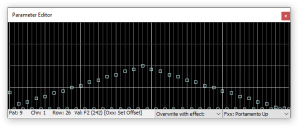Manual: Parameter Editor

The Parameter Editor window is the most graphical display of pattern data in OpenMPT. The window does not only show the effect values for one channel (the first channel within the selection) for the selected rows, but you can also modify the data with a few actions. The Parameter Editor can also be used to set the parameter values of plugin Parameter Control Events. For this, the first row of the selection must control a Parameter Control Event, or any of the following rows if no other effect commands are present in the selection.
Each vertical line represents one row in the pattern; effect values are implied up and down these vertical rods, with higher values at the top of the grid. The squares are handles that indicate the parameter value, and can be dragged up or down their axis to change the value. Left-clicking allows you to “paint” values across several axes, while right-clicking will only edit the selected row, no matter how far left or right you move the mouse cursor.
In the bottom left corner is some helpful info that translates the mouse cursor position on the parameter editor to a pattern position. From left to right, there is the pattern number, the channel number, the row number, and the effect value at the mouse cursor position.
In the bottom right corner are two fields indicating first, the action to execute when clicking in the window, then second, the effect command to apply. Clicking on the field will open a list where you can make your selections. To use the window, slide a square along a vertical axis, or click at an axis and drag the mouse to shape how you want the values to interpolate. Doing so will apply values according to the following actions:
- Overwrite with effect: When clicking or dragging in the window, the value will be placed in the corresponding row and will apply the effect command you have selected in the second field, overwriting any existing effect commands.
- Overwrite effect next to note: Same as “Overwrite with effect”, but only applies any changes to rows on which a note is placed as well.
- Fill blanks with effect: When clicking or dragging in the window, the value will be placed in the corresponding row and will apply the effect command you have selected in the second field only in rows where there are no existing effect command yet. If there is already a different effect command on the row, its parameter value is updated, but the effect type is not changed.
- Overwrite with PC Note: Same as “Overwrite with effect”, with the difference that it inserts Parameter Control Events instead of a specified effect command.
- Fill blanks with PC Note: Same as “Fill blanks with effect”, with the difference that it inserts Parameter Control Events instead of a specified effect command.
- Never change effect type: This is similar to “Fill blanks with effect”, but with the difference that no effect is written into blank effect cells.
It should be noted, however, that the parameters of all effects are always shown in the grid, no matter which overwrite option is selected; so if you have a channel with different effect commands, all values are displayed here, no matter what command they belong to.
Keep in mind that, while the values you modify are updated immediately in the channel (and vice versa), modifications only occur in the channel in which the Parameter Editor was opened. To edit values in another channel you have to choose Visualize Effect again from the context menu in another channel (or type its keyboard shortcut).